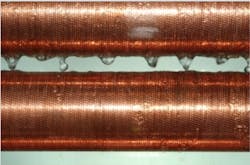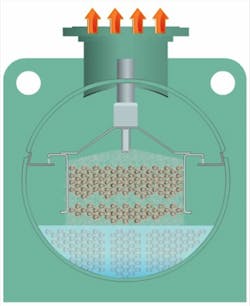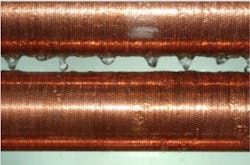Falling Film Advantage: Big Step for Chiller Performance
By IAN CASPER, VP, Strategic Programs, Global Chiller Products, Building Technologies & Solutions, Johnson Controls
The advantages of a falling film evaporator are based on the kinds of work that a chiller evaporator does. The evaporator is where liquid refrigerant boils into a gas as it contacts tube surfaces heated by warm return chilled water. Functioning as a large heat exchanger, the efficiency of an evaporator is a function of tube surface area and how the two liquids -- refrigerant and return chilled water -- interface with the outer and inner tube surfaces, respectively.
In a traditional flooded evaporator design, the tubes are covered with refrigerant. The liquid refrigerant passes through a variable orifice, enters the bottom of the evaporator and fills the evaporator shell with liquid refrigerant to ensure that refrigerant adequately covers all the tubes. As the refrigerant boils off the tubes, it is sucked through a mist eliminator or baffle assembly and up into the compressor to continue the vapor-compression cycle.
The refrigerant and return chilled water interface differently in falling film evaporators. In a hybrid falling film evaporator design, for example, the shell is not filled with refrigerant to submerge all the tubes. Instead, a thin film of refrigerant only covers the surface of the upper tubes. Liquid refrigerant passes through the variable orifice and is sent to a header at the top of the evaporator. From there, liquid refrigerant is evenly distributed and sprayed down over the evaporator tubes. About half of the sprayed refrigerant is instantly evaporated. The other half is collected at the bottom of the evaporator. There, the remaining refrigerant is boiled off from the submerged tubes, just as with a flooded design. The evaporated refrigerant passes through baffles along the side of the shell ensuring no liquid is carried over as the gas is sucked into the compressor.
As any cook who pours a little water into a hot pan knows, heat transfer is very effective when a thin film of liquid contacts a hot surface. For that reason, heat transfer in falling film evaporators is very efficient. The evaporation of a thin refrigerant film covering a tube happens more easily than with submerged tubes. The high heat transfer coefficient boosts chiller efficiency.
Thanks to improved heat transfer efficiency, falling film evaporators require a smaller refrigerant charge than a flooded evaporator design. Some centrifugal and screw chillers with a falling film evaporator use 20 percent less refrigerant and still provide the same cooling capacity of a conventional evaporator. The improved performance makes it possible to shrink the size of falling-film evaporator shells and the chiller footprint. Using less refrigerant also reduces refrigerant costs. Along with reduced refrigerant charge and increased efficiency, some chillers using hybrid falling film technology qualify for LEED Energy and Atmosphere Credit #4 (EAc4) – Enhanced Refrigerant Management.
Simpler chiller design is also an advantage. With a falling film evaporator, a screw chiller is less dependent on an oil separator to achieve peak performance. Compressor design is more reliable, because many connecting parts and potential leak points are reduced.
To get all the advantages of falling film technology, however, it's important that every element--evaporator, condenser, compressor, refrigerant charge--are optimized for superior system efficiency. Looking forward, falling film evaporators will especially be advantageous as more expensive HFO refrigerant blends become mainstream. Meanwhile, the thermodynamics, smaller refrigerant charge, and reliability of the falling film evaporator design can help meet environmental and energy goals now, and in the future.
This article first appeared in the December 2017 print edition of HPAC Engineering magazine.


